David's Astronomy Pages
|
Notes (S199) |
Notes (Main) |
Home Page |
Notes (S210) |
|
Need for improved Polar Alignment Polar Alignment Checks from Star Drift Measurements Some comments on the Drift Align Method Polar Check/Align Diary >
From checking the drift of stars during recent sessions it was established that the Scope's Polar Axis was an estimated 3.8 arc min too low and 5.8 arc min too far west. (ie out by 7 arc minutes). Whilst not a barrier to acquisition of star targets (due to TPoint modelling and automated star centering tools) the polar misalignment was causing stars to drift across a CCD image at rates of up to 1.5 arc sec/minute. This is equivalent to 0.6 pixel per minute drift at my normal CCD imaging setup (2x2 binning, F6.7).
Drift rates are lower away from the Dec 0 deg, and therefore I've been generally able to get away with unguided image exposures of up to 3 minutes, without significant star trailing. Whilst I can employ autoguiding for particular targets, it is not generally suitable for automated acquisition run or when trying to acquire images through filters (esp B Filter). Where a series of long exposure images are taken (eg 10 x 180 secs) or a long run of shorter images (eg 200 x 15 secs), there is a tendancy for a target star/object to drift away form the image centre, such that subsequent averaged/summed aligned images have to be cropped to a slightly smaller area.
For very long runs (eg a star transit) a particular star drift could theoretically drift from the centre to the edge of my CCD field of view in a 3-4 hour period. Reference stars closer to the edge might drift out of view within just 20-30 minutes, requiring regular manual correction or autoguiding. Problem with standard autoguiding with my ST7 camera is the difficulty of finding a suitable guide star in small FOV and insufficient robustness to the passing cloud where guide star becomes lost.
For highly accurate differential photometry (necessary for any successful attempt at exoplanet transit detection) it is vital that target and reference stars are kept fixed on specific pixels for the duration of the imaging session. For this purpose I have developed my own software routines for autoguiding (which employ guiding corrections between image frames and are robust to both cosmic ray artefacts and passing clouds. Despite this procedure a residual amount of field rotation can still cause movement of reference/target stars between CCD pixels. Also it still doesn't allow for exposures of > 3 minutes, since star trailing may still occur between guide corrections, which are only made between frames. Overall there is still an advantage for to minimize the number of guiding corrections, due to unwanted guiding effects (eg where a guide in Declination introduces a small unwanted error in RA). This is due to the weaknesses in the Dec drive system on my old style LX200 and where perfect backlash correction can't be achieved.
Back to Top
Polar Alignment checks were made on 2007-08-14. The involves firstly measuring the N-S drift of a star near to Meridian & Declination 0 (South Sky Point) and then the N-S star drift on a star close to either western horizon (West Sky Point) or alternatively close to eastern horizon. Only N-S drifts are considered.
N-S drift of a star at South Star point indicates an issue
with East/West pointing of the telescope's polar axis, whilst N-S drif of a star
at the West Star point indicates an issue with the inclination of the scope's
polar axis.
For the northern hemisphere (where I am), the following rules apply
- South sky point
star drifts north --> scope's polar axis pointing too far west and needs turning clockwisestar drifts south --> scope's polar axis pointing too far east and needs turning anti-clockwise
- West sky point
star drifts north --> scope's polar axis pointing too low and needs raising
star drifts south --> scope's polar axis pointing too high and needs lowering
With a little trigonometry the rate of drift can be used to
calculate the approximate amount of polar misalignment.
From stra drift checks during recent sessions it was estimated the the
scope's polar axis was pointing 3.8
arc min too low and 5.8 arc min too far west. (ie out by 7 arc
minutes).
|
Images during Polar Alignment Check (2007-08-14) |
|
South Sky Point Animation of 2 images taken 3 minutes apart illustrating northwards drift of 1.6 arc sec/min caused by 6.3 arc minutes misalignment in polar axis azimuth. (the slight drift in RA is either due principally to the inclination misalignment in the polar axis or Periodic Error and is ignored - it's the N-S drift that is measured) |
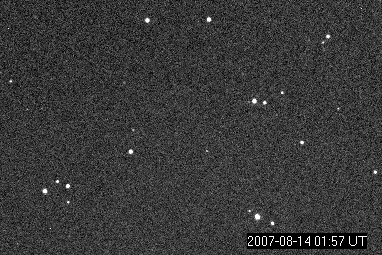
|
| West Sky Point Animation of 2 images taken 3 minutes apart illustrating northwards drift of 1.0 arc sec/min caused by 3.8 arc minutes misalignment in polar axis inclination (the obvious drift in RA is due principally to the azimuthal misalignment in the polar axis and is ignored - it's the N-S drift that is measured) |
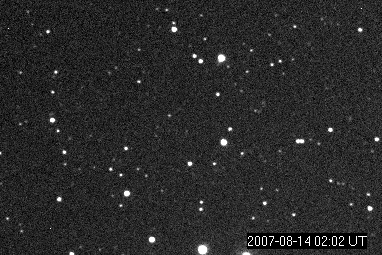
|
|
|
|
Control Tool used to perform Slews to South & West Sky Points |
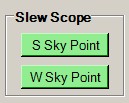
|
|
Control Tool used to perform Automated Image Capture / Drift Analysis |

|
| Log file associated with Polar Alignment Check |
|
Slew to South
Sky Point Measuring N-S
Drift |
CCD Assisted Polar Alignment
To help address the above issues it was decided to make an improved polar alignment attempt. This was not done without some hesitation due to the 'danger' of loosing the reasonable accurate alignment that I already have. The controls to allow my scope wedge to be raised/lowered and rotated are somewhat stiff and prone to significant re-movement when locking down after alignment.
After reviewing my planned procedure and
confident that the potential benefits outweighed the risks, an improved polar
alignment was attempted at the end of Session 208 (2007-08-27). The
steps taken are tabulated below, together with comments and results.
(In the end it was concluded that the drift align method still left residual
Polar Misalignment and it was subsequently decided to improve polar alignment
using information form TPoint mapping -
Improving Polar Alignment with TPoint)
| Step | Procedure | Comment | ||
| 1) Determine Polar Misalignment | Determined Polar Misalignment by analysing N-S drift of star in southern and western skies (at approx Dec 0) | Used
measurements made on previous observing session
Required action : Turn polar axis clockwise by 5.8 arc mins. Raise Polar axis clockwise by 3.8 arc min |
||
| 2) Correct Polar Axis Misalignement (azimuth) | Slew to South Sky Point (Dec 0 / Due South, and centered a reasonably bright star | The South Sky point is a convenient position to understand the operations being made. Also being at Dec 0 increases the accuracy of azimuthal corrections. | ||
| Check that star lies in a area of sufficient stars that 20 sec exposure can be successfully image linked | This provides a backup in case the bright target star is accidentally moved out of the FOV and is 'lost'. | |||
| Identify suitable exposure for tracking the bright star, and turn on cross-hair feature on CCD imaging software (if available0 | A 2 sec
exposure (at 2x2 binning) was found appropriate to show the target star
and a couple of adjacent fainter stars (useful later as a ID check to
ensure the correct target star is being followed).
Key '6' turns on centre cross-hair in CCDSoft |
|||
| Take out any backlash in RA | I needed to make an E jog, so I jogged the scope first W and then back E to recentre the bright star. (not sure if this step is necessary for RA drive, but performed anyway) | |||
| Take 20 sec baseline image | Image linking the image records the initial position | |||
| Jog scope
E/W by required amount for clockwise axis change jog scope East, whilst for a anticlockwise axis change jog scope West |
I needed to make a clockwise axis change of 5.8 arc mins, so I jogged the scope East by 5.8 arc mins | |||
| Take 20 sec check image and confirm that required jog has been successfully applied | I checked
that scope has correctly jogged East by ~ 5.8 arc mins.
Note is possible to abort and start again since no change to wedge position has yet been made. |
|||
| Set CCD to continuous snap images | 2 sec exposures, Cross Hair turned on | |||
| Loosen wedge manual knob (and 3 additional knobs if applicable), rotate wedge in fine increments in required direction whilst watching CCD frames, stop when target star is perfectly recentred. | After 2
years I found that wedge was initially very stiff to turn / minor
corrosion between wedge and pier plate, and the azimuth control knobs
couldn't exert enough leverage to move the wedge, requiring me to
manually made to 'force' the wedge (loosing the target star, a 20 sec
exposure /imaged linked then allowed me to find out how far I had
overshoot).
Loosing the wedge knobs causes a slight drop/rise in Dec position (ignore this for the moment) |
|||
| Tighten Wedge knobs(s) and ensure that target star remains centred | Loosing the wedge knobs causes a slight drop/rise in Dec position, however this is normally recovered when knobs are re-tightened. Adjusting the order in which knobs are tighten allows the target star to be perfectly recentred. | |||
| Take 20 sec check image | Image linking the image records the final position. Position should ideally match the initial position. | |||
| 3) Correct Polar Axis Misalignement (inclination) | Take out any backlash in Dec drive | I need to make a N jog, so I jogged the scope S and then back N to recentre the bright star. | ||
| Take 20 sec baseline image | Image linking the baseline image records the initial position | |||
| Jog scope
N/S by required amount For raising the polar axis jog scope North, whilst to drop the polar axis jog scope South |
I needed to raise the polar axis by 3.8 arc mins, so I jogged the scope North by 3.8 arc mins | |||
| Take 20 sec check image and confirm that required jog has been successfully applied | I checked
that scope has correctly jogged North by ~3.8 arc mins.
Note is possible to abort and start again since no change to wedge position has yet been made. |
|||
| Set CCD to continuous snap images | 2 sec exposures, Cross Hair turned on | |||
| Slightly
loosen the 2 tilt angle adjustment knobs on side of wedge. Then adjust
Latitude Control knob in fine increments in required direction whilst
watching CCD frames, stop when target star is recentred.
To raise the Polar Axis turn Latitude Contol knob in
clockwise direction. |
I need to
raise the Polar axis which required Tilt Plate to be made less steep,
achieved by means of clockwise turns of the Latitude Control knob. Quite
a few turns of the knob were seemingly needed even though I was only
raising the polar axis by 3.8 arc mins.
Loosing/tightening the tilt angle adjustment knobs causes small change in RA position, and a larger change in Dec position. The Dec position change may need to be allowed for when making the Latitude changes. Any RA position change should be noted but otherwise ignored for the moment |
|||
| Tighten tilt angle adjustment knobs and ensure that target star remains centred | Loosing/tightening the tilt angle adjustment knobs causes small change in RA position, and a larger change in Dec position. Tilt plate adjustments may need to be repeated to ensure that the target star lies in the central cross-hair position after knobs are finally tightened/locked. | |||
| Take 20 sec check image | Image linking the image records the final position. Position should ideally match the initial position. | |||
| 4) Re-Check Polar Misalignment | Determine Polar Misalignment by analysing N-S drift of star in southern and western skies (at approx Dec 0) | Star drift was measured in each case by analysing two images taken 5 minutes apart. | ||
| 5) Correct Polar Axis Misalignement (azimuth / inclination) | Repeat Step 2 |
|
||
| Repeat Step 3 | ||||
| 6) Re-Check Polar Misalignment | Determine Polar Misalignment by analysing N-S drift of star in southern and western skies (at approx Dec 0) | . |
| Images during Refined Polar Alignment
(2007-08-28) showing Polar Axis Inclination Correction in progress |
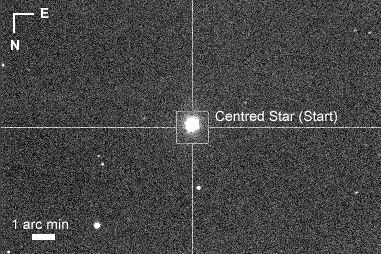
|
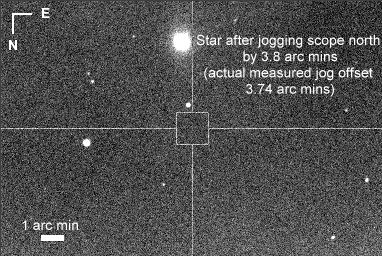
|
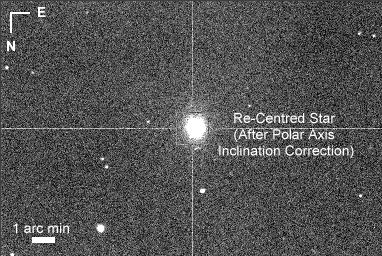
|
|
Annotated CCD Images 20 sec exposure, 2x2 binning, C Filter 2007-08-28 (#208106,111,113) |
| Control Tool used to perform telescope Jog |

|
Back to Top
In theory the drift align method provides an accurate way of achieving very good polar alignment and is certainly very handy when the polar star is either obscured or can't be viewed/imaged with CCD equipment due to fork construction on an SCT like the LX200.
In practice a number of issues are noted that make it difficult to achieve a precise polar alignment, or make it particularly tedious.
Imperfections in
the telescope's mount limit, mean that single drift align check limits the the accuracy of drift align results and
their dependability for polar alignment. The problem appears to be
greatest with measuring star drift associated with star on Western or
Eastern horizon where flexure in the scope's tube and/or CCD mounting are
likely to be greatest.
Because the TPoint method is statistical it means that, with appropriate
care, it is better able to provide a correct view on required polar
alignment changes
The drift align method generally demands that
drift checks have to be intermixed with polar axis azimuth and inclinations
changes, ie changing either azimuth or inclination of the Polar Axis changes
the star drift results associated with both azimuth and inclination. ie
there seems to be no shortcut
Using TPoint method, Polar axis Azimuth and Inclination corrections
can be made together in a single combined step.
It is unclear what the best sky point for
measuring the N-S drift associated with a star on the 'Western' (or
'Eastern' horizon). This is illustrated in the diagram below.
Observatory wall prevents viewing a star close to the western horizon, and
it is unclear whether it is best to compromise sacrifice poximity to Due
West but remain close to Dec 0 or whether to sacrifice proximity to Dec 0 in
order to preserve 90 deg offset from the meridian.
Drift measurements suggested that N-S star drift rates varied significantly
between the different points.
| Uncertainty over the optimum Western Sky Point for Drift Analysis |
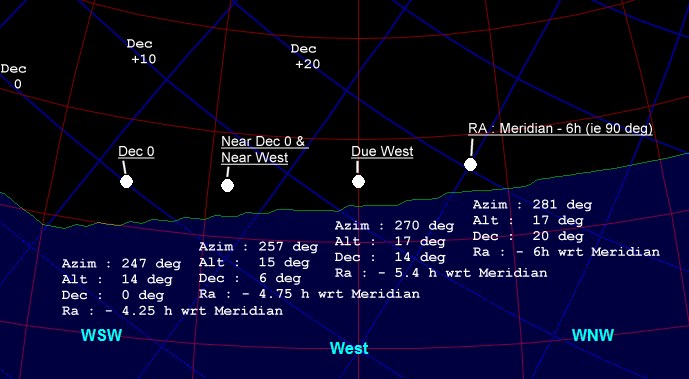
|
Back to Top
Diary of Drift Check / Drift Align Results
|
2007-08-13 (S204) |
|
Drift Checks. (3 minute periods) South Sky Point :
Northwards Drift at a rate of 1.64 arc secs/min West Sky Point :
Northwards Drift at a rate of 0.81 arc secs/min |
|
Polar axis i) needs turning clockwise by 6.3 arc min and ii) needs raising by 3.1 arc min |
|
|
|
2007-08-22 (S206) |
|
Drift Checks. (4 minute periods) South Sky Point :
Northwards Drift at a rate of 1.41 arc secs/min West Sky Point :
Northwards Drift at a rate of 1.12 arc secs/min ( Due
West / Dec +16 deg) |
|
Polar axis i) needs turning clockwise by 5.4 arc min and ii) needs raising by 4.3 arc min |
|
Average results (S204/S206) : |
|
|
|
2007-08-27 (S208) |
|
Polar Alignment Adjustment
(using CCD-assisted Polar Axis Correction) |
|
Drift Checks. (5 minute periods) South Sky Point :
Northwards Drift at a rate of 0.40 arc secs/min West Sky Point :
Northwards Drift at a rate of 0.3 arc secs/min ( Near
Dec 0 W/WSW) |
|
Polar axis i) needs turning clockwise by
1.5 arc min and ii) needs raising by 1.2 arc min |
|
Polar Alignment Adjustment
(using CCD-assisted Polar Axis Correction) |
|
|
|
2007-09-02 (S209) |
|
Drift Check. (6 minute period) South Sky Point :
Southwards Drift at a rate of 0.05 arc secs/min Drift Checks. (5 minute periods) West Sky Point : Southwards
Drift at a rate of 0.80 arc secs/min ( Azim 270 (W) /
Dec +16 deg) West Sky Point 2: Southwards
Drift at a rate of 0.52 arc secs/min ( Azim 249 / Dec
+3 deg) East Sky Point :
Northwards Drift at a rate of 0.31 arc secs/min ( Azim
104 (E) / Dec +7 deg) |
|
Polar axis i) needs turning anti-clockwise by 0.2 arc min and ii) needs lowering by 1.2 - 3.1 arc min |
|
|
|
2007-09-03 (S210) |
|
Polar Alignment Adjustment
(using CCD-assisted Polar Axis Correction)
|
|
Drift Checks (5 minute periods) South Sky Point :
Northwards Drift at a rate of 0.25 arc secs/min West Sky Point 1 :
Southwards Drift at a rate of 0.40 arc secs/min ( Azim
270 (W) / Dec +16 deg) West Sky Point 2:
Northwards Drift at a rate of 0.50 arc secs/min ( Azim
249 / Dec +3 deg) |
|
Polar axis i) needs turning
anti-clockwise by 0.2 arc min and ii) needs lowering by 1.5 or raising by
1.9 arc min |
|
|
|
TPoint Mapping Run Polar axis i) needs turning clockwise by
2.5 arc min and ii) needs lowering by 3.0 or 7.7 arc mins |
|
|
|
2007-09-10 (S211) |
|
Polar Alignment Adjustment
(using CCD-assisted Polar Axis Correction) |
|
|
Back to Top
| This Web Page: | Notes - Session 208 (2007-08-27) |
| Last Updated : | 2015-05-16 |
| Site Owner : | David Richards |
| Home Page : | David's Astronomy Web Site |